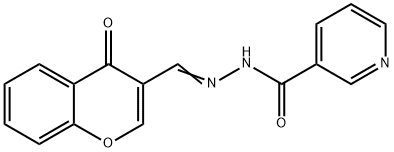Description
Signal Transducers and Activators of Transcriptions (STATs) are a family of cytoplasmic latent transcription factors that are activated to regulate gene expression in response to a large number of extracellular signaling polypeptides including cytokines, interferons, and growth factors. STAT5, which consists of two isoforms STAT5α and STAT5β, is known to be overactive in several kinds of leukemias and various solid tumors. STAT5 Inhibitor is a cell-
permeable, nonpetidic nicotinoyl hydrazone that suppresses STAT5 by targeting its SH2 domain (IC
50 = 47 μM against STAT5β SH2 domain EPO peptide binding activity). Comparatively, this compound exhibits reduced potency towards inhibiting the SH2 domain of STAT1, STAT3, or Lck (IC
50 > 500 μM). STAT5 Inhibitor has been shown to block STAT5/STAT5 DNA binding in K562 nuclear extracts.
Uses
2-?[(4-?Oxo-?4H-?1-?benzopyran-?3-?yl)?methylene]?hydrazide-3-?pyridinecarboxylic Acid is a selective inhibitor of STAT5.
Definition
ChEBI: A carbohydrazide that is nicotinohydrazide in which the terminal nitrogen has undergone formal condensation with the aldehyde group of 4-oxo-4H-chromene-3-carbaldehyde. It is an inhibitor of STAT5 (Signal Transducer and Activator of Tran
cription 5) protein.
References
[1]. müller j, sperl b, reindl w, et al. discovery of chromone-based inhibitors of the transcription factor stat5. chembiochem. 2008 mar 25;9(5):723-7.
[2]. leonard wj, o'shea jj. jaks and stats: biological implications. annu rev immunol. 1998;16:293-322.
[3]. schindler c, darnell je jr. transcriptional responses to polypeptide ligands: the jak-stat pathway. annu rev biochem. 1995;64:621-51.
